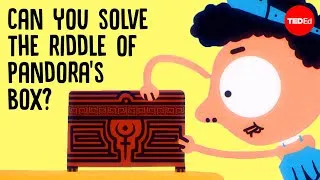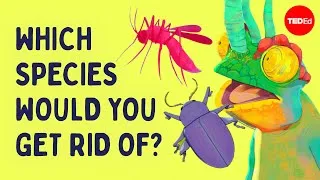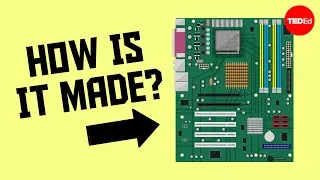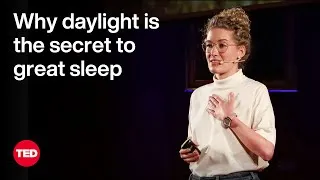請雙擊下方英文字幕播放視頻。
譯者: HUI XU
審譯者: Joan Liu
00:12
I want you to imagine that you're a student in my lab.
0
12160
5000
我想讓你想像一下,你是我實驗室裡的一個學生。
00:17
What I want you to do is to create a biologically inspired design.
1
17160
4000
我想讓你做的是提出一個由生物激發的設計。
00:21
And so here's the challenge:
2
21160
2000
挑戰是這樣的:
00:23
I want you to help me create a fully 3D, dynamic, parameterized contact model.
3
23160
6000
我想讓你幫我製造出一個全部是三維,動態,參數化的接觸模型。
00:29
The translation of that is, could you help me build a foot?
4
29160
4000
解釋一下,就是能不能幫我造一隻腳?
00:33
And it is a true challenge, and I do want you to help me.
5
33160
2000
這件事真的頗具挑戰性,我確實需要你來幫我。
00:35
Of course, in the challenge there is a prize.
6
35160
2000
當然,這一挑戰是有獎勵的。
00:37
It's not quite the TED Prize, but it is an exclusive t-shirt from our lab.
7
37160
7000
不能算是TED的獎品,而是我們實驗室提供的特別版T卹。
00:44
So please send me your ideas about how to design a foot.
8
44160
6000
因此,請將你們就如何設計一隻腳的想法發給我。
00:50
Now if we want to design a foot, what do we have to do?
9
50160
4000
如果我們想設計一隻腳,我們必須要做哪些呢?
00:54
We have to first know what a foot is.
10
54160
3000
首先我們要知道腳是什麼。
00:57
If we go to the dictionary, it says, "It's the lower extremity of a leg
11
57160
3000
如果去查看字典,字典上解釋說:“腳是腿的最末端
01:00
that is in direct contact with the ground in standing or walking"
12
60160
2000
在站立或行走時直接接觸地面的部位。”
01:02
That's the traditional definition.
13
62160
1000
這是傳統的定義。
01:03
But if you wanted to really do research, what do you have to do?
14
63160
3000
但如果你真的想要做研究,要做哪些呢?
01:06
You have to go to the literature and look up what's known about feet.
15
66160
3000
你要去查閱文獻,看關於腳人們都知道了些哪些。
01:09
So you go to the literature. (Laughter)
16
69160
2000
所以你去查閱文獻。(大笑)
01:12
Maybe you're familiar with this literature.
17
72160
2000
也許你很熟悉這些文獻。
01:14
The problem is, there are many, many feet.
18
74160
3000
問題是,這裡有很多很多只腳。
01:17
How do you do this?
19
77160
1000
該怎麼辦呢?
01:18
You need to survey all feet and extract the principles of how they work.
20
78160
5000
你需要研究所有的腳,並提煉出這些腳是如何工作的原理。
01:23
And I want you to help me do that in this next clip.
21
83160
2000
在下一張圖上,我想讓你來幫我做這件事。
01:25
As you see this clip, look for principles,
22
85160
3000
當你看這張圖時,注意尋找原理。
01:28
and also think about experiments that you might design
23
88160
3000
並且想一下你可能會設計的實驗
01:31
in order to understand how a foot works.
24
91160
4000
為了弄明白腳是如何工作的。
01:44
See any common themes? Principles?
25
104160
2000
看到有什麼共同點了嗎?共同的原理?
01:46
What would you do?
26
106160
3000
你要怎麼做?
01:59
What experiments would you run?
27
119160
2000
要進行什麼樣的實驗?
03:31
Wow. (Applause)
28
211160
6000
哇。(鼓掌)
03:37
Our research on the biomechanics of animal locomotion
29
217160
3000
我們關於動物運動的生物力學研究
03:40
has allowed us to make a blueprint for a foot.
30
220160
2000
讓我們繪製一隻腳的藍圖。
03:42
It's a design inspired by nature, but it's not a copy of any specific foot you just looked at,
31
222160
6000
這是一個由自然啟發的設計,但不是複製你剛才看到的某只特定的腳,
03:48
but it's a synthesis of the secrets of many, many feet.
32
228160
4000
而是綜合了許多許多只腳的秘密。
03:52
Now it turns out that animals can go anywhere.
33
232160
3000
事實是動物哪兒都能去。
03:55
They can locomote on substrates that vary as you saw --
34
235160
2000
它們能在各種不同的表面上移動——
03:57
in the probability of contact, the movement of that surface
35
237160
4000
這些變化因素包括接觸形勢,表面的運動
04:01
and the type of footholds that are present.
36
241160
3000
以及它們所呈現的不同的立足點。
04:04
If you want to study how a foot works,
37
244160
2000
如果你想要研究腳是如何工作的
04:06
we're going to have to simulate those surfaces, or simulate that debris.
38
246160
4000
我們就需要模擬這些表面,或那些碎片。
04:10
When we did that, here's a new experiment that we did:
39
250160
5000
當我們進行模擬時,這裡是我們做的一個新實驗:
04:15
we put an animal and had it run -- this grass spider --
40
255160
2000
我們將一隻動物放上去然後讓它跑——這是一隻草蛛——
04:17
on a surface with 99 percent of the contact area removed.
41
257160
3000
被放在一個99%的接觸區域都已經被移走的表面上。
04:20
But it didn't even slow down the animal.
42
260160
2000
但它甚至沒有减慢動物的移動。
04:22
It's still running at the human equivalent of 300 miles per hour.
43
262160
3000
草蛛仍以相當於人類300英里/小時的速度移動著。
04:25
Now how could it do that? Well, look more carefully.
44
265160
3000
它是怎麼辦到的?好的,仔細看。
04:28
When we slow it down 50 times we see how the leg is hitting that simulated debris.
45
268160
6000
當我們將其速度减少50倍,就可以看到腿是如何接觸那些模擬碎片的。
04:34
The leg is acting as a foot.
46
274160
2000
腿發揮了腳的功能。
04:36
And in fact, the animal contacts other parts of its leg
47
276160
3000
事實上,動物用腿的其他部位接觸表面
04:39
more frequently than the traditionally defined foot.
48
279160
3000
比用傳統定義界定的足頻繁得多。
04:42
The foot is distributed along the whole leg.
49
282160
4000
沿著整條腿分佈的都是腳。
04:46
You can do another experiment where you can take a cockroach with a foot,
50
286160
4000
你可以做另一個實驗,用一隻腳的蟑螂,
04:50
and you can remove its foot.
51
290160
2000
然後把它所有的腳都去掉。
04:52
I'm passing some cockroaches around. Take a look at their feet.
52
292160
4000
我在分發一些蟑螂。來看看他們的腳是什麼樣子的。
04:56
Without a foot, here's what it does. It doesn't even slow down.
53
296160
4000
沒有了腳,看他們怎麼走。它甚至都沒有慢下來。
05:00
It can run the same speed without even that segment.
54
300160
3000
沒有腳它們仍可以以同樣的速度移動。
05:03
No problem for the cockroach -- they can grow them back, if you care.
55
303160
3000
蟑螂不會出現任何問題——它們還能把腳長回來,如果你在意。
05:06
How do they do it?
56
306160
2000
它們是怎麼做到的?
05:08
Look carefully: this is slowed down 100 times,
57
308160
3000
仔細看:這是放慢100倍後,
05:11
and watch what it's doing with the rest of its leg.
58
311160
3000
觀察他們在用腿的其餘部分做什麼。
05:14
It's acting, again, as a distributed foot --
59
314160
3000
又一次,腿作為被廣泛分佈的足了。
05:17
very effective.
60
317160
2000
非常有效。
05:19
Now, the question we had is, how general is a distributed foot?
61
319160
5000
現在問題是,到底有多少動物有類似的分佈足?
05:24
And the next behavior I'll show you of this animal just stunned us the first time that we saw it.
62
324160
9000
下面將要為你們展示的這個動物,我們第一次看時就感到很震驚。
05:33
Journalists, this is off the record; it's embargoed.
63
333160
5000
記者們,這可是沒人報導過的,被禁止的——
05:38
Take a look at what that is!
64
338160
2000
看那是什麼!
05:40
That's a bipedal octopus that's disguised as a rolling coconut.
65
340160
7000
這個兩足的章魚佯裝成一個可以滾動的椰子。
05:47
It was discovered by Christina Huffard
66
347160
4000
是克里斯蒂娜•胡法德發現了它
05:51
and filmed by Sea Studios, right here from Monterey.
67
351160
3000
這影片由海洋工作室(海工作室),就在蒙特瑞拍攝的。
05:56
We've also described another species of bipedal octopus.
68
356160
5000
我們也描述了另一種雙足章魚。
06:01
This one disguises itself as floating algae.
69
361160
3000
這一只將自己偽裝成浮動的海藻。
06:04
It walks on two legs and it holds the other arms up in the air so that it can't be seen.
70
364160
5000
它用兩條腿走路然後將兩隻胳膊高舉在空中,以保證不讓其他生物看見。
06:09
(Applause)
71
369160
1000
(鼓掌)
06:10
And look what it does with its foot to get over challenging terrain.
72
370160
8000
注意看,當他們要通過崎嶇不平的地面時是如何使用腳的。
06:18
It uses that beautiful distributed foot to make it as if those obstacles are not even there --
73
378160
11000
它用它們那美麗均勻分佈的足,使得這些障礙好似不存在一般。
06:29
truly extraordinary.
74
389160
2000
真的很特別。
06:33
In 1951, Escher made this drawing. He thought he created an animal fantasy.
75
393160
4000
在1951年,埃舍爾畫了這幅畫。他覺得自己創造出了一個動物神話。
06:38
But we know that art imitates life,
76
398160
2000
但是我們知道藝術模仿生命,
06:40
and it turns out nature, three million years ago, evolved the next animal.
77
400160
3000
事實就是300萬年前,自然進化出下一個動物。
06:43
It's a shrimp-like animal called the stomatopod,
78
403160
2000
這個像小蝦的動物被稱為口腳類動物,
06:45
and here's how it moves on the beaches of Panama:
79
405160
4000
這裡是它如何在巴拿馬的海灘上移動的:
06:49
it actually rolls, and it can even roll uphill.
80
409160
4000
它其實在滾動,而且它甚至還能向上滾。
06:53
It's the ultimate distributed foot: its whole body in this case is acting like its foot.
81
413160
8000
這最終是因為均勻分佈的足,在這種情況下,它的整個身子都扮演著腳的角色。
07:03
So, if we want to then, to our blueprint, add the first important feature,
82
423160
5000
因此我們為我們的藍圖上加上第一個重要的特徵,
07:08
we want to add distributed foot contact.
83
428160
2000
我們想加上均勻分佈的足的接觸面。
07:10
Not just with the traditional foot, but also the leg,
84
430160
3000
不僅是加在傳統的足部部位,也加在腿上。
07:13
and even of the body.
85
433160
1000
而且甚至是在身上。
07:14
Can this help us inspire the design of novel robots?
86
434160
4000
這能有助於我們設計出新的機器人嗎?
07:18
We biologically inspired this robot, named RHex,
87
438160
3000
我們受到生物的啟示所創造的機器人,叫做RHex,
07:21
built by these extraordinary engineers over the last few years.
88
441160
4000
它是由這些卓越的工程師在過去幾年間製造出來的。
07:25
RHex's foot started off to be quite simple,
89
445160
3000
RHex的腳一開始時非常簡單,
07:28
then it got tuned over time, and ultimately resulted in this half circle.
90
448160
5000
但是它總是隨時間而改變,最後變成了這樣的半圓形。
07:33
Why is that? The video will show you.
91
453160
2000
為什麼呢?接下來的錄像將告訴你答案。
07:35
Watch where the robot, now, contacts its leg in order to deal with this very difficult terrain.
92
455160
7000
看這個機器人,現在,看它用腿的什麼部位接觸這些有障礙的地表,試圖翻越過去。
07:42
What you'll see, in fact, is that it's using that half circle leg as a distributed foot.
93
462160
6000
你會看到,事實上,它用這半圓形的腳當做均勻分佈的足了。
07:48
Watch it go over this.
94
468160
2000
看它翻越這裡。
07:50
You can see it here well on this debris.
95
470160
2000
你可以從這裡看它穿過這些碎片。
07:53
Extraordinary. No sensing, all the control is built right into the tuned legs.
96
473160
6000
非常棒。沒有傳感裝置,所有的控制組件都裝在這個諧調的腿中了。
07:59
Really simple, but beautiful.
97
479160
2000
很簡單,但非常棒。
08:01
Now, you might have noticed something else about the animals
98
481160
3000
現在,你可能已經注意到了這些動物的其他方面
08:04
when they were running over the rough terrain.
99
484160
2000
當它們跑過崎嶇不平的地表面時。
08:06
And my assistant's going to help me here.
100
486160
2000
我的助手在這要幫我一下。
08:08
When you touched the cockroach leg -- can you get the microphone for him?
101
488160
4000
當你摸蟑螂的腿時——你能幫我把話筒遞給他嗎?
08:12
When you touched the cockroach leg, what did it feel like?
102
492160
3000
當你摸蟑螂的腿時,有什麼感覺?
08:15
Did you notice something?
103
495160
2000
感覺到什麼不同了嗎?
08:17
Boy: Spiny.
104
497160
1000
男孩:很多刺。
08:18
Robert Full: It's spiny, right? It's really spiny, isn't it? It sort of hurts.
105
498160
4000
羅伯特•福爾:很多刺,是嗎?感覺很扎,對不對?有點傷手。
08:22
Maybe we could give it to our curator and see if he'd be brave enough to touch the cockroach.
106
502160
6000
也許我們應該把蟑螂給監護人,看他有沒有勇氣也摸一摸。
08:28
(Laughter)
107
508160
1000
(笑)
08:29
Chris Anderson: Did you touch it?
108
509160
1000
克里斯•安德森:你摸過嗎?
08:30
RF: So if you look carefully at this, what you see is that they have spines
109
510160
3000
羅伯特•福爾:所以當你很仔細的觀察,會發現上面真的有很多剛毛。
08:33
and until a few weeks ago, no one knew what they did.
110
513160
3000
直到幾週前,一直也沒人知道這些刺是用來做什麼的。
08:36
They assumed that they were for protection and for sensory structures.
111
516160
3000
他們推測那些刺起到保護以及用來感知周圍結構用的。
08:39
We found that they're for something else -- here's a segment of that spine.
112
519160
4000
後來我們發現它們有別的功效——這裡是剛毛的一部分
08:43
They're tuned such that they easily collapse in one direction
113
523160
3000
它們的構造使得它們都很容易向一個方向傾斜
08:46
to pull the leg out from debris,
114
526160
2000
把一條腿從碎片中拔出,
08:48
but they're stiff in the other direction so they capture disparities in the surface.
115
528160
6000
這些毛很硬,不會彎向另一個方向,因此可以對付不同的表面。
08:54
Now crabs don't miss footholds, because they normally move on sand --
116
534160
3000
螃蟹不需要尋找立足點,因為他們通常在沙子上行走——
08:57
until they come to our lab.
117
537160
1000
直到他們來到我們的實驗室。
08:59
And where they have a problem with this kind of mesh,
118
539160
3000
然後他們在這些網子上移動會遇到問題,
09:02
because they don't have spines.
119
542160
2000
因為他們沒有剛毛。
09:05
The crabs are missing spines, so they have a problem in this kind of rough terrain.
120
545160
3000
螃蟹由於沒有剛毛,所以在這些不平整的表面上移動會有問題。
09:08
But of course, we can deal with that
121
548160
3000
但當然,我們能幫助它們,
09:11
because we can produce artificial spines.
122
551160
3000
因為我們可以製造人工剛毛。
09:15
We can make spines that catch on simulated debris
123
555160
3000
我們可以製造人工剛毛,他們能夠吸附在模擬碎片上
09:18
and collapse on removal to easily pull them out.
124
558160
3000
而且在我們不需要它們時還能很容易的拔出。
09:21
We did that by putting these artificial spines on crabs,
125
561160
3000
我們把這些人造剛毛裝在螃蟹腿上,
09:24
as you see here, and then we tested them.
126
564160
2000
你看,我們測試一下。
09:26
Do we really understand that principle of tuning? The answer is, yes!
127
566160
4000
我們真正明白調諧的原理了嗎?答案是:對!
09:30
This is slowed down 20-fold, and the crab just zooms across that simulated debris.
128
570160
5000
這是放慢20倍後的,螃蟹飛速的橫穿過這個模擬碎片。
09:35
(Laughter) (Applause)
129
575160
2000
(笑聲)(掌聲)
09:37
A little better than nature.
130
577160
2000
比自然形成的稍微好一點。
09:40
So to our blueprint, we need to add tuned spines.
131
580160
3000
所以在我們的藍圖上,要加上具有調諧作用的剛毛 。
09:43
Now will this help us think about the design of more effective climbing robots?
132
583160
5000
這些可以幫助我們設計出更會爬牆的機器人嗎?
09:48
Well, here's RHex: RHex has trouble on rails -- on smooth rails, as you see here.
133
588160
5000
這是RHex——RHex穿過軌道時遇到了麻煩——在平滑的軌道上,你看。
09:53
So why not add a spine? My colleagues did this at U. Penn.
134
593160
4000
為什麼不加一根剛毛呢?我的同事幫他加上了。
09:57
Dan Koditschek put some steel nails -- very simple version -- on the robot,
135
597160
4000
丹•柯蒂斯將一些鋼釘——非常簡單的型號-裝在機器人上——
10:01
and here's RHex, now, going over those steel -- those rails. No problem!
136
601160
6000
於是現在的RHex,越過那些鋼製的——軌道。沒有問題!
10:07
How does it do it?
137
607160
1000
它是怎麼做到的?
10:08
Let's slow it down and you can see the spines in action.
138
608160
2000
我們放慢速度,你就能看到那些剛毛是如何發揮作用的了。
10:10
Watch the leg come around, and you'll see it grab on right there.
139
610160
3000
看腿移動過來了,你看它剛好能抓穩。
10:13
It couldn't do that before; it would just slip and get stuck and tip over.
140
613160
3000
以前它是辦不到的,只會打滑,卡住然後翻倒。
10:16
And watch again, right there -- successful.
141
616160
4000
現在再看一遍,就這樣——成功。
10:20
Now just because we have a distributed foot and spines
142
620160
3000
現在只因為裝上均勻分佈的足以及剛毛
10:23
doesn't mean you can climb vertical surfaces.
143
623160
2000
並不代表可以爬上垂直的表面。
10:26
This is really, really difficult.
144
626160
2000
這個真的非常,非常難。
10:28
But look at this animal do it!
145
628160
2000
但看動物們,它們能辦到!
10:30
One of the ones I'm passing around is climbing up this vertical surface that's a smooth metal plate.
146
630160
6000
其中有這樣一個動物,它是在光滑的金屬盤子表面垂直向上爬。
10:36
It's extraordinary how fast it can do it --
147
636160
2000
它們的爬行速度快得驚人——
10:38
but if you slow it down, you see something that's quite extraordinary.
148
638160
4000
看如果放慢速度,你會發現一些很神奇的事。
10:42
It's a secret. The animal effectively climbs by slipping and look --
149
642160
4000
這是個秘密。動物很有效的利用滑動,看-
10:46
and doing, actually, terribly, with respect to grabbing on the surface.
150
646160
4000
事實上,糟糕的是,它們在抓取表面。
10:50
It looks, in fact, like it's swimming up the surface.
151
650160
3000
事實上,看上去像從表面上游了上去。
10:53
We can actually model that behavior better as a fluid, if you look at it.
152
653160
4000
我們其實可以將這一行為模仿為流動體的,如果你仔細觀察。
10:57
The distributed foot, actually, is working more like a paddle.
153
657160
4000
這些分佈式足事實上工作原理更像是槳。
11:01
The same is true when we looked at this lizard running on fluidized sand.
154
661160
4000
當我觀察蜥蜴在流態化的沙子上移動時,結果相同。
11:05
Watch its feet.
155
665160
2000
看它的腳。
11:07
It's actually functioning as a paddle
156
667160
2000
事實上它起到了槳的作用。
11:09
even though it's interacting with a surface that we normally think of as a solid.
157
669160
6000
即使它接觸的表面通常被我們認為是固體。
11:15
This is not different from what my former undergraduate discovered
158
675160
5000
這與我以前的一個大學部學生所發現的沒有什麼不同
11:20
when she figured out how lizards can run on water itself.
159
680160
4000
當她發現蜥蜴是如何在水面上行走的。
11:25
Can you use this to make a better robot?
160
685160
5000
可以利用這個製造更好的機器人嗎?
11:30
Martin Buehler did -- who's now at Boston Dynamics --
161
690160
3000
馬丁•比埃勒進行了嘗試——他現在在波士頓動力公司——
11:33
he took this idea and made RHex to be Aqua RHex.
162
693160
5000
他採用了這個點子並將 RHex改造為水族RHex。
11:38
So here's RHex with paddles,
163
698160
2000
所以RHex有了趟水的槳,
11:40
now converted into an incredibly maneuverable swimming robot.
164
700160
5000
現在被改造為不可思議且操縱靈活的游泳機器人了。
11:46
For rough surfaces, though, animals add claws.
165
706160
3000
然而對於粗糙的表面,動物為自己添加了爪子。
11:49
And you probably feel them if you grabbed it.
166
709160
1000
當你抓住它們時應該能感覺到這些爪子。
11:50
Did you touch it?
167
710160
1000
你有沒有碰碰它?
11:51
CA: I did.
168
711160
1000
CA:我碰了。
11:52
RF: And they do really well at grabbing onto surfaces with these claws.
169
712160
2000
RF:它們可以很有效的利用這些爪子鉗住表面。
11:54
Mark Cutkosky at Stanford University, one of my collaborators, is an extraordinary engineer
170
714160
6000
斯坦福大學的馬克•庫特科斯基,我的一位同事,是一位傑出的工程師
12:00
who developed this technique called Shape Deposition Manufacturing,
171
720160
3000
他發明了一種技術叫做“形狀沉積製造",
12:03
where he can imbed claws right into an artificial foot.
172
723160
3000
利用這種技術,他可以將爪子嵌入人工足中。
12:06
And here's the simple version of a foot for a new robot that I'll show you in a bit.
173
726160
5000
這裡有一個新機器人腳的簡易版本,我給你們看看。
12:11
So to our blueprint, let's attach claws.
174
731160
3000
在我們的藍圖上加上爪子。
12:14
Now if we look at animals, though, to be really maneuverable in all surfaces,
175
734160
3000
現在讓我們看看那些真正能在任何表面上移動的動物,
12:17
the animals use hybrid mechanisms
176
737160
2000
它們都要用到混合動力機制
12:19
that include claws, and spines, and hairs, and pads, and glue, and capillary adhesion
177
739160
4000
包括爪子,刺,毛髮,肉趾,膠,毛細管粘附
12:23
and a whole bunch of other things.
178
743160
1000
還有很多其他的東西。
12:24
These are all from different insects.
179
744160
2000
這些都是來自不同的昆蟲。
12:26
There's an ant crawling up a vertical surface.
180
746160
2000
這裡有一隻螞蟻在垂直的表面上往上爬。
12:28
Let's look at that ant.
181
748160
1000
讓我們來看一下這隻螞蟻。
12:30
This is the foot of an ant. You see the hairs and the claws and this thing here.
182
750160
5000
這是螞蟻的一隻腳。你看這裡有毛髮以及爪子。
12:35
This is when its foot's in the air.
183
755160
2000
這是螞蟻自然狀態下的腳。
12:37
Watch what happens when the foot goes onto your sandwich.
184
757160
4000
觀察這腳放在你的三明治上會發生些什麼。
12:41
You see what happens?
185
761160
2000
看到發生了些什麼了嗎?
12:43
That pad comes out. And that's where the glue is.
186
763160
4000
這些墊伸展出來。這就是膠所在的地方。
12:48
Here from underneath is an ant foot,
187
768160
3000
這下面是一隻螞蟻腳。
12:51
and when the claws don't dig in, that pad automatically comes out without the ant doing anything.
188
771160
6000
當爪子不深入抓取時,墊會自動出來不需要螞蟻做任何事情。
12:57
It just extrudes.
189
777160
1000
它就自己出來。
12:58
And this was a hard shot to get -- I think this is the shot of the ant foot on the superstrings.
190
778160
5000
很難拍攝到這種狀態——這大概是在超弦狀態下拍攝的螞蟻腳。
13:03
So it's pretty tough to do.
191
783160
1000
真的很難辦到。
13:04
This is what it looks like close up --
192
784160
3000
這就是近看的效果——
13:07
here's the ant foot, and there's the glue.
193
787160
2000
這是一隻螞蟻腳,然後這裡是膠狀物。
13:09
And we discovered this glue may be an interesting two-phase mixture.
194
789160
4000
而且我們發現這些膠狀物可能是兩相混合物。
13:13
It certainly helps it to hold on.
195
793160
2000
這顯然可以幫助它們抓住牆壁。
13:15
So to our blueprint, we stick on some sticky pads.
196
795160
4000
所以要在我們的藍圖上添加黏膠墊。
13:19
Now you might think for smooth surfaces we get inspiration here.
197
799160
4000
現在你可以考慮光滑表面了,因為我們已經有了相應的靈感。
13:23
Now we have something better here.
198
803160
3000
在這裡我們有些更好的。
13:26
The gecko's a really great example of nanotechnology in nature.
199
806160
3000
壁虎絕對是自然界中最好的納米技術例子。
13:29
These are its feet.
200
809160
2000
這些是他的腳。
13:31
They're -- almost look alien. And the secret, which they stick on with,
201
811160
4000
他們看起來——甚至像外星人的腳。而且秘密在於
13:35
involves their hairy toes.
202
815160
2000
他們有毛茸茸的腳趾頭。
13:37
They can run up a surface at a meter per second,
203
817160
4000
它們可以以1公尺/秒的速度在表面上移動。
13:41
take 30 steps in that one second -- you can hardly see them.
204
821160
3000
一秒鐘內走30步——你幾乎都看不到它們。
13:44
If we slow it down, they attach their feet at eight milliseconds,
205
824160
3000
但如果我們將這一過程放慢,會發現它們的腳與表面接觸時間僅為8毫秒,
13:47
and detach them in 16 milliseconds.
206
827160
3000
而腳離開表面的時間僅為16毫秒。
13:50
And when you watch how they detach it, it is bizarre.
207
830160
7000
當你觀察它們是如何將腳與表面分開時,會感覺很奇怪。
13:57
They peel away from the surface like you'd peel away a piece of tape.
208
837160
5000
他們把腳從表面撕開,就像你把膠帶撕開一樣。
14:02
Very strange. How do they stick?
209
842160
3000
很奇怪。他們是怎麼黏上的?
14:05
If you look at their feet, they have leaf-like structures called linalae
210
845160
3000
觀察他們的腳,你會發現這種葉狀結構叫做linalae,
14:08
with millions of hairs.
211
848160
1000
並且有成千上萬的毛髮。
14:09
And each hair has the worst case of split ends possible.
212
849160
3000
而且每根毛都分岔極為嚴重。
14:12
It has a hundred to a thousand split ends,
213
852160
3000
又分了成百上千個岔。
14:15
and that's the secret, because it allows intimate contact.
214
855160
3000
這就是秘密,因為這樣可以更為親密的接觸表面。
14:18
The gecko has a billion of these 200-nanometer-sized split ends.
215
858160
4000
壁虎擁有10億個這樣200奈米大小的分岔。
14:22
And they don't stick by glue, or they don't work like Velcro, or they don't work with suction.
216
862160
5000
它們不利用膠狀物,不用尼龍搭扣(魔術帶),也不用吸附力。
14:27
We discovered they work by intermolecular forces alone.
217
867160
4000
我們發現它們只用分子間引力作用。
14:31
So to our blueprint, we split some hairs.
218
871160
4000
所以在我們的藍圖上,我們將一些毛髮分岔。
14:35
This has inspired the design of the first self-cleaning dry adhesive --
219
875160
3000
這也為第一個具有自我清潔能力的膠提供了設計靈感——
14:38
the patent issued, we're happy to say.
220
878160
2000
我們很開心的說我們也獲得了專利。
14:40
And here's the simplest version in nature,
221
880160
3000
這裡是自然界中最簡單的版本。
14:43
and here's my collaborator Ron Fearing's attempt
222
883160
3000
這是我的同事羅恩•菲爾凌的嘗試
14:46
at an artificial version of this dry adhesive made from polyurethane.
223
886160
5000
利用聚氨酯製造這種人工乾膠。
14:51
And here's the first attempt to have it work on some load.
224
891160
3000
這是第一次試驗將其黏在同樣的表面上。
14:54
There's enormous interest in this in a variety of different fields.
225
894160
3000
在很多領域裡,人們都對其非常感興趣。
14:57
You could think of a thousand possible uses, I'm sure.
226
897160
3000
我敢保證你能想出上千種用途。
15:00
Lots of people have, and we're excited about realizing this as a product.
227
900160
5000
很多人發現了這是一種產品,我們對此也很激動。
15:05
We have imagined products; for example, this one:
228
905160
2000
我們曾經想像過要製造這樣的產品,比如這個:
15:08
we imagined a bio-inspired Band-Aid, where we took the glue off the Band-Aid.
229
908160
5000
我們想像由生物啟發的護創貼布(ok蹦),可以不用黏膠。
15:13
We took some hairs from a molting gecko;
230
913160
2000
我們在蛻皮的壁虎身上取得一些毛髮;
15:15
put three rolls of them on here, and then made this Band-Aid.
231
915160
4000
將三卷毛髮用在此處,製造出新的護創貼布(ok蹦)。
15:19
This is an undergraduate volunteer --
232
919160
2000
這是一位大學生志願者——
15:21
we have 30,000 undergraduates so we can choose among them --
233
921160
3000
我們有三萬個大學生,所以可以從他們之中挑選——
15:24
that's actually just a red pen mark.
234
924160
2000
這僅僅是個紅色筆印。
15:26
But it makes an incredible Band-Aid.
235
926160
2000
但這方法真的製造出了不可思議的護創貼布(ok蹦)。
15:28
It's aerated, it can be peeled off easily, it doesn't cause any irritation, it works underwater.
236
928160
8000
充氣後,可以被輕易地揭掉,不會帶來小困擾,而且還具有防水功能。
15:36
I think this is an extraordinary example of how curiosity-based research --
237
936160
5000
我認為這是一個非常好的例子,來說明基於好奇的研究-——
15:41
we just wondered how they climbed up something --
238
941160
2000
我們只是好奇它們如何爬上一些表面的——
15:43
can lead to things that you could never imagine.
239
943160
3000
可以引領你發現一些想不到的事情。
15:46
It's just an example of why we need to support curiosity-based research.
240
946160
4000
這是一個例子來說明為什麼我們需要支持那些由好奇心啟發的研究。
15:50
Here you are, pulling off the Band-Aid.
241
950160
3000
現在你撕掉創可貼。
15:53
So we've redefined, now, what a foot is.
242
953160
4000
所以現在我們對腳重新進行了定義。
15:57
The question is, can we use these secrets, then,
243
957160
2000
問題是,我們可否用這些秘密
15:59
to inspire the design of a better foot, better than one that we see in nature?
244
959160
3000
來啟發我們設計出比自然形成的更好的腳嗎?
16:02
Here's the new project:
245
962160
2000
這是一個新的項目:
16:04
we're trying to create the first climbing search-and-rescue robot -- no suction or magnets --
246
964160
6000
我們試圖製造第一個可爬牆的搜索救援機器人——不用吸盤以及磁鐵——
16:10
that can only move on limited kinds of surfaces.
247
970160
3000
可以在特定的表面上移動。
16:13
I call the new robot RiSE, for "Robot in Scansorial Environment" -- that's a climbing environment --
248
973160
5000
我稱這個新機器人為高層,是“攀登環境機器人“的簡稱——它可以爬牆。
16:18
and we have an extraordinary team of biologists and engineers creating this robot.
249
978160
4000
我們共同製造這個機器人的小組中有傑出的生物學家以及工程師。
16:22
And here is RiSE.
250
982160
2000
這就是RiSE。
16:26
It's six-legged and has a tail. Here it is on a fence and a tree.
251
986160
3000
它有6條腿和一條尾巴。這是它在一個籬笆上,還有在一顆樹上。
16:29
And here are RiSE's first steps on an incline.
252
989160
4000
這是RiSE在傾斜的表面走出的第一步。
16:33
You have the audio? You can hear it go up.
253
993160
3000
你們有耳機吧?可以聽到它往上走。
16:36
And here it is coming up at you, in its first steps up a wall.
254
996160
6000
它在向你走來,第一次爬牆。
16:42
Now it's only using its simplest feet here, so this is very new.
255
1002160
5000
這裡它僅僅用最簡單的腳,所以很新。
16:47
But we think we got the dynamics right of the robot.
256
1007160
3000
但是我想我們已經理解了這個機器人的動力裝置。
16:51
Mark Cutkosky, though, is taking it a step further.
257
1011160
2000
馬克•庫特科斯基將這個實驗更進一步。
16:53
He's the one able to build this shape-deposition manufactured feet and toes.
258
1013160
5000
他可以利用形狀沉積製造的技術來製造這些腳以及趾頭。
16:58
The next step is to make compliant toes,
259
1018160
4000
下一步是要製造順從聽話的腳趾頭。
17:02
and try to add spines and claws and set it for dry adhesives.
260
1022160
2000
然後加上刺和爪子,再加上乾膠。
17:04
So the idea is to first get the toes and a foot right,
261
1024160
3000
我們計劃首先將腳趾和腳做好,
17:07
attempt to make that climb, and ultimately put it on the robot.
262
1027160
3000
然後試圖讓腳能在牆上爬行,最後在其上面安裝機器人。
17:10
And that's exactly what he's done.
263
1030160
2000
他就是這麼做的。
17:12
He's built, in fact, a climbing foot-bot inspired by nature.
264
1032160
5000
事實上,他製造出一個受自然啟發的腳踏式爬牆機器人。
17:17
And here's Cutkosky's and his amazing students' design.
265
1037160
4000
這就是特科斯基以及他令人佩服的學生的設計作品。
17:21
So these are tuned toes -- there are six of them,
266
1041160
6000
這些就是調諧的腳趾——有6個,
17:27
and they use the principles that I just talked about collectively for the blueprint.
267
1047160
9000
它們就將我剛才在藍圖上用到的原理綜合起來。
17:36
So this is not using any suction, any glue,
268
1056160
2000
沒有用到吸盤,或任何膠狀物,
17:38
and it will ultimately, when it's attached to the robot --
269
1058160
3000
最終,當它被裝到機器人身上後——
17:41
it's as biologically inspired as the animal --
270
1061160
3000
由動物啟發而來——
17:44
hopefully be able to climb any kind of a surface.
271
1064160
5000
希望能在任何表面上爬行。
17:49
Here you see it, next, going up the side of a building at Stanford.
272
1069160
5000
現在你看,接下來,它爬上斯坦福大學建築的一面牆。
17:54
It's sped up -- again, it's a foot climbing.
273
1074160
3000
它加速了——它一直是用腳爬行。
17:57
It's not the whole robot yet, we're working on it --
274
1077160
2000
這還不是全部的機器人,我們仍在繼續努力——
17:59
now you can see how it's attaching.
275
1079160
1000
現在你可以看到它是怎麼爬上去的。
18:00
These tuned structures allow the spines, friction pads and ultimately the adhesive hairs
276
1080160
6000
這些調諧的結構使得所有刺、摩擦墊以及最終用來附著的毛髮
18:06
to grab onto very challenging, difficult surfaces.
277
1086160
3000
可以抓附住這些非常具有挑戰性的表面
18:09
And so they were able to get this thing -- this is now sped up 20 times --
278
1089160
4000
所以它們現在可以爬牆了——這個影片加速了20倍——
18:13
can you imagine it trying to go up and rescue somebody at that upper floor? OK?
279
1093160
4000
你能想像它爬上去救在上層的人嗎?
18:17
You can visualize this now; it's not impossible.
280
1097160
2000
你完全可以這麼設想了,不是不可能。
18:19
It's a very challenging task. But more to come later.
281
1099160
4000
這是一項非常具有挑戰性的工作。但我們還有很多要做。
18:23
To finish: we've gotten design secrets from nature by looking at how feet are built.
282
1103160
4000
結束之際,當我們觀察腳是的構造時,我們汲取了自然界中設計的奧秘。
18:27
We've learned we should distribute control to smart parts.
283
1107160
3000
我們學到應該把控制力巧妙的分部。
18:30
Don't put it all in the brain,
284
1110160
1000
不是全部放在腦子裡,
18:31
but put some of the control in tuned feet, legs and even body.
285
1111160
4000
而是去琢磨琢磨調諧的足、腿甚至身體。
18:35
That nature uses hybrid solutions, not a single solution, to these problems,
286
1115160
3000
自然界為解決這類問題都使用多種途徑,絕不是單一途徑,
18:38
and they're integrated and beautifully robust.
287
1118160
3000
這些途徑都完美的結合在一起,而且十分有效。
18:41
And third, we believe strongly that we do not want to mimic nature but instead be inspired by biology,
288
1121160
8000
第三,我們堅定的相信我們不要單純模仿自然,而是要從生物中汲取靈感,
18:49
and use these novel principles with the best engineering solutions that are out there
289
1129160
4000
然後利用這些新的原理以及最好的工程解決方案
18:53
to make -- potentially -- something better than nature.
290
1133160
3000
來製造——有可能——比自然更好的東西。
18:57
So there's a clear message:
291
1137160
2000
所以信息明確:
18:59
whether you care about a fundamental, basic research
292
1139160
3000
不論你在意的是基礎研究
19:02
of really interesting, bizarre, wonderful animals,
293
1142160
3000
關於那些有趣、奇怪而奇妙的動物,
19:05
or you want to build a search-and-rescue robot
294
1145160
1000
或者你想製造一個可以用來搜尋及營救的機器人
19:06
that can help you in an earthquake, or to save someone in a fire,
295
1146160
3000
來幫助你在地震或火災中救人
19:09
or you care about medicine, we must preserve nature's designs.
296
1149160
5000
再或你對醫藥感興趣,總之我們必須保留大自然的設計。
19:14
Otherwise these secrets will be lost forever.
297
1154160
3000
否則這些秘密就將永遠丟失了。
19:17
Thank you.
298
1157160
1000
謝謝。
New videos
關於本網站
本網站將向您介紹對學習英語有用的 YouTube 視頻。 您將看到來自世界各地的一流教師教授的英語課程。 雙擊每個視頻頁面上顯示的英文字幕,從那裡播放視頻。 字幕與視頻播放同步滾動。 如果您有任何意見或要求,請使用此聯繫表與我們聯繫。







